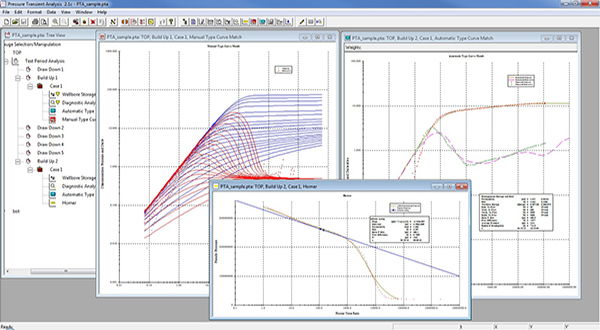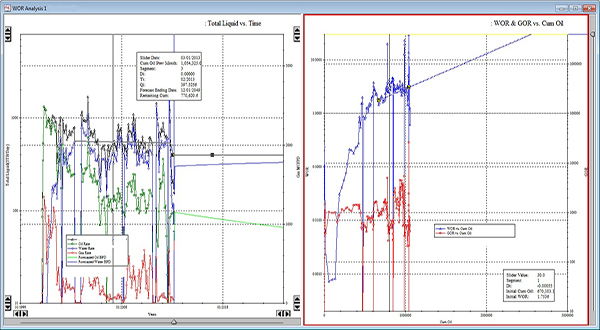PTA©
Pressure Transient Analysis Tool
The most common usage of the PTA© program is for analysis of pressure transient data from buildups, drawdowns, falloffs, and DST’s. Multiple analysis options are available to analyze test periods which include multiple straight line analyses techniques, (Horner, Infinite Acting Radial Flow, Pseudosteady State, Radial Superposition, Fracture Linear Flow, Fracture Bilinear Flow, and Spherical Flow), automatic type curve matching using non linear regression, and manual type curve matching. In order to aide in accurately determining appropriate testing procedures PTA© includes a Design section. The Design section will allow you to simulate test responses using estimated reservoir properties to obtain optimum test duration and flow rate prior to or during the test. PTA© also has the ability to analyze gas well deliverability tests.
Analysis
The most common usage of the PTA© program is for analysis of pressure transient data from buildups, drawdowns, falloffs, and DST’s. Multiple analysis options are available to analyze test periods which include multiple straight line analyses techniques, (Horner, Infinite Acting Radial Flow, Pseudosteady State, Radial Superposition, Fracture Linear Flow, Fracture Bilinear Flow, and Spherical Flow), automatic type curve matching using non linear regression, and manual type curve matching. To view a detailed tutorial of how to use this portion of the program click on analysis tutorial button.
The Analysis
module in PTA© allows you to rigorously analyze pressure transient data
collected from DST’s, buldups, drawdowns, and falloffs using a variety
of techniques. From the analysis of pressure transient data you can
obtain information about the well and reservoir such as skin,
permeability, fracture properties, and distances to boundaries.
Design
In order to aide in accurately determining appropriate testing procedures PTA© includes a Design section. The Design section will allow you to simulate test responses using estimated reservoir properties to obtain optimum test duration and flow rate prior to or during the test.
The Design module in PTA© allows you to obtain an estimated reservoir
response during a pressure transient test. The basic concept behind a
design is that you estimate the reservoir parameters such as effective
permeability and skin as well as reservoir model response. This input
can then be used to evaluate the proper duration and type of test to
conduct in order to obtain measured pressure data which can then be
analyzed for accurate reservoir parameters.
Deliverability
PTA© also has the ability to analyze gas well deliverability tests. To view a detailed tutorial of how to use this portion of the program click on the deliverability tutorial button.
The Analysis
module in PTA© allows you to analyze deliverability data from Flow
After Flow Tests, Isochronal Tests, and Modified Isochronal Tests to
obtain an AOF (absolute open flow) potential. Oil deliverability
analyses require only pressure and rate data. Gas deliverability
analyses require gas properties in addition to pressure and rate data.
The deliverability analysis can be done as a stand alone analysis, or
it can be done in conjunction with a full analysis of the transient
data.



